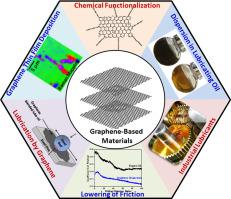Advances in Colloid and Interface Science ( IF 15.6 ) Pub Date : 2020-07-30 , DOI: 10.1016/j.cis.2020.102215 Ajay Chouhan 1 , Harshal P Mungse 2 , Om P Khatri 1

|
Graphene, the most promising material of the decade, has attracted immense interest in a diversified range of applications. The weak van der Waals interaction between adjacent atomic-thick lamellae, excellent mechanical strength, remarkable thermal conductivity, and high surface area, make graphene a potential candidate for tribological applications. However, the use of graphene as an additive to liquid lubricants has been a major challenge because of poor dispersibility. Herein, a thorough review is presented on preparation, structural models, chemical functionalization, and dispersibility of graphene, graphene oxide, chemically-functionalized graphene, and graphene-derived nanocomposites. The graphene-based materials as additives to water and lubricating oils improved the lubrication properties by reducing the friction, protecting the contact interfaces against the wear, dissipating the heat from tribo-interfaces, and mitigating the corrosion by forming the protecting thin film. The dispersion stability, structural features, and dosage of graphene-based dispersoids, along with contact geometry, play important roles and govern the tribological properties. The chemistry of lubricated surfaces is critically reviewed by emphasizing the graphene-based thin film formation under the tribo-stress, which minimizes the wear. The comprehensive review provides variable approaches for the development of high-performance lubricant systems and accentuates the lubrication mechanisms by highlighting the role of graphene-based materials for enhancement of tribological properties.
中文翻译:

石墨烯和氧化石墨烯的表面化学:分散和摩擦学应用的通用途径。
石墨烯是近十年来最有希望的材料,它在各种应用中引起了极大的兴趣。相邻原子厚薄片之间的弱范德华相互作用,优异的机械强度,出色的导热性和高表面积使石墨烯成为摩擦学应用的潜在候选者。但是,由于分散性差,使用石墨烯作为液体润滑剂的添加剂一直是主要挑战。在此,对石墨烯,氧化石墨烯,化学官能化的石墨烯和石墨烯衍生的纳米复合材料的制备,结构模型,化学官能化和分散性进行了全面的综述。石墨烯基材料作为水和润滑油的添加剂,可通过减少摩擦来改善润滑性能,通过形成保护薄膜,保护接触界面免受磨损,消散摩擦界面的热量并减轻腐蚀。石墨烯基分散质的分散稳定性,结构特征和用量以及接触几何形状起着重要的作用,并控制着摩擦学性能。通过强调摩擦应力下石墨烯基薄膜的形成,可以最大限度地减少磨损,从而对润滑表面的化学性能进行了严格的审查。全面的综述提供了开发高性能润滑剂系统的多种方法,并通过强调石墨烯基材料在增强摩擦学性能方面的作用来强调润滑机理。通过形成保护薄膜来减轻腐蚀。石墨烯基分散质的分散稳定性,结构特征和用量以及接触几何形状起着重要的作用,并控制着摩擦学性能。通过强调摩擦应力下石墨烯基薄膜的形成,可以最大限度地减少磨损,从而对润滑表面的化学性能进行了严格的审查。全面的综述提供了开发高性能润滑剂系统的多种方法,并通过强调石墨烯基材料在增强摩擦学性能方面的作用来强调润滑机理。通过形成保护薄膜来减轻腐蚀。石墨烯基分散质的分散稳定性,结构特征和用量以及接触几何形状起着重要的作用,并控制着摩擦学性能。通过强调摩擦应力下石墨烯基薄膜的形成,可以最大限度地减少磨损,从而对润滑表面的化学性能进行了严格的审查。全面的综述提供了开发高性能润滑剂系统的多种方法,并通过强调石墨烯基材料在增强摩擦学性能方面的作用来强调润滑机理。发挥重要作用并控制摩擦学特性。通过强调摩擦应力下石墨烯基薄膜的形成,可以最大限度地减少磨损,从而对润滑表面的化学性能进行了严格的审查。全面的综述提供了开发高性能润滑剂系统的多种方法,并通过强调石墨烯基材料在增强摩擦学性能方面的作用来强调润滑机理。发挥重要作用并控制摩擦学特性。通过强调摩擦应力下石墨烯基薄膜的形成,可以最大限度地减少磨损,从而对润滑表面的化学性能进行了严格的审查。全面的综述提供了开发高性能润滑剂系统的多种方法,并通过强调石墨烯基材料在增强摩擦学性能方面的作用来强调润滑机理。


























 京公网安备 11010802027423号
京公网安备 11010802027423号